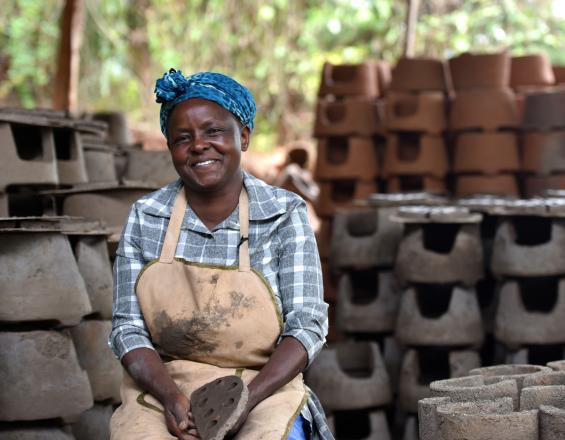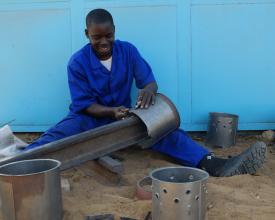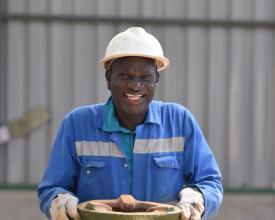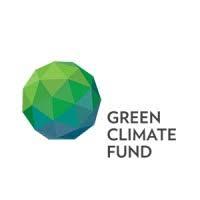
Fomento de la cocina respetuosa con el clima: Kenia y Senegal

Alrededor del 15% de la demanda energética mundial se satisface con biomasa clásica, como leña o carbón vegetal. Unos 2.800 millones de personas cocinan sus comidas diarias con este tipo de biomasa. La combustión de biomasa durante la cocción libera gases de efecto invernadero (GEI). El Grupo Intergubernamental de Expertos sobre el Cambio Climático señala que el uso de cocinas mejoradas podría ahorrar emisiones equivalentes a 0,6-2,4 gigatoneladas de CO₂ cada año.
El objetivo del proyecto es ampliar el crecimiento del mercado de estufas mejoradas en ambos países de forma sostenible y a largo plazo para reducir así las emisiones de GEI. Esto se consigue apoyando tanto a la oferta (productores de estufas mejoradas) como a la demanda (clientes), a través de las siguientes actividades:
(a) Profesionalización de la producción, ampliación de las estructuras de distribución y venta al por menor y fomento del acceso a la financiación.
(b) Sensibilizar a los consumidores y crear un entorno de mercado favorable.
En cuanto al componente global, se compartirán los conocimientos generados por el proyecto, con el objetivo de ampliar el enfoque.
Contexto
Défis à relever
Las principales barreras pueden dividirse en barreras de la oferta y barreras de la demanda. Por el lado de la oferta son:
- Escasa base tecnológica y capacidades para mejorar los procesos de producción de las ICS y el diseño de productos que se adapten a las necesidades de los consumidores.
- Cadena de suministro de SIC poco desarrollada, ya que ni siquiera las soluciones básicas de SIC llegan a las zonas rurales remotas.
- Acceso limitado a la financiación debido a razones como la informalidad, los altos tipos de interés y los requisitos de garantía.
Por el lado de la demanda
- Falta de confianza en los nuevos productos y vendedores debido a que las campañas de marketing y sensibilización no llegan a los mercados rurales.
- Escasa concienciación sobre los riesgos que conllevan las prácticas culinarias tradicionales y los múltiples beneficios de las SIC, así como su importancia para el gasto familiar, la salud y el medio ambiente.
- Entornos de mercado poco favorables debido a problemas políticos, institucionales y de coordinación.
Ubicación
Procesar
Resumen del proceso
Ambos pilares -las medidas relativas a la demanda y a la oferta- son fundamentales para aplicar con éxito el enfoque del proyecto, ya que son interdependientes. Con la aplicación de este doble enfoque, el proyecto garantiza el crecimiento sostenible y a largo plazo del mercado de ICS, incluso después de su finalización.
Bloques de construcción
Aumento sostenible de la producción de cocinas mejoradas
Apoyar a los productores artesanales, profesionales y de clase empresarial de SCI para que aumenten su producción proporcionándoles herramientas para incrementar la eficiencia de los procesos de los talleres, así como servicios de desarrollo empresarial que les permitan aumentar sus ventas.
Factores facilitadores
El proyecto utiliza un enfoque basado en el mercado para facilitar el crecimiento del mercado de las ICS. En términos de este enfoque, el proyecto permite a los productores de ICS apoyados aumentar significativamente su producción de estufas respetuosas con el clima, así como su alcance en el mercado. Además, el proyecto facilita el acceso de los productores de ICS a la financiación basada en el mercado. A ello se añaden medidas del lado de la demanda para aumentar el conocimiento sobre los beneficios de las tecnologías de cocción mejoradas, especialmente en las zonas rurales, así como para mejorar el entorno propicio.
Lección aprendida
Para poner en marcha este desarrollo, el mercado de la ICS en el país o región en cuestión debe haber pasado ya de la fase Precomercial a la Pionera, lo que significa que ya existen unas cuantas empresas artesanales de ICS, en su mayoría informales y con un volumen de ventas bajo, y canales de distribución existentes pero débiles, situados en su mayoría en entornos urbanos o periurbanos.
Aumentar la demanda de cocinas mejoradas mediante la comunicación para el cambio de comportamiento.
El proyecto presta especial atención a las medidas relacionadas con la demanda en términos de comunicación para el cambio de comportamiento, especialmente en las zonas rurales. De este modo, el proyecto pretende aumentar los conocimientos de las poblaciones destinatarias sobre los beneficios de las SCI para garantizar que los hogares compren SCI y las integren en su sistema de energía para cocinar.
Factores facilitadores
Para aumentar la demanda a mayor escala, el proyecto está llevando a cabo una amplia gama de actividades relacionadas con la demanda. Entre ellas se incluyen la difusión a través de emisoras de radio nacionales y regionales, la inserción del producto en telenovelas, la sensibilización de los líderes locales y los agentes de extensión del gobierno, así como eventos en caravana y actuaciones culinarias en mercados locales y comunidades.
Lección aprendida
Para poner en marcha este desarrollo, el mercado de las ICS en el país o región en cuestión debe haber pasado ya de la fase precomercial a la fase pionera, lo que significa que el mercado es cada vez más consciente de las tecnologías y sus ventajas y que los primeros en adoptarlas ya las utilizan.
Impactos
El proyecto limitará significativamente el consumo de biomasa no renovable en el sector de la cocina en comparación con la situación de referencia. Esto conducirá a una reducción de las emisiones de gases de efecto invernadero (GEI) de 6,47 megatoneladas de CO2 equivalente durante el periodo del proyecto y a una reducción adicional de 24,77 megatoneladas de CO2 equivalente hasta 2030. Por lo tanto, permitirá a Senegal y Kenia alcanzar sus objetivos declarados de reducción de emisiones de GEI en el sector energético.
Además, el proyecto beneficia directamente a 11,23 millones de personas y a 1,91 millones de hogares, principalmente rurales, incluidos 610.000 hogares encabezados por mujeres y 5,57 millones de niños, proporcionándoles acceso a tecnologías de cocción más limpias.
El proyecto está financiado conjuntamente por el Fondo Verde para el Clima (GCF), el Ministerio Federal Alemán de Cooperación Económica y Desarrollo (BMZ), el Ministerio de Energía de Kenia, así como el Ministerio de Petróleo y Energía y el Ministerio de Medio Ambiente y Desarrollo Sostenible de Senegal.
Beneficiarios
Al ampliar el mercado de la ICS, los hogares rurales y, por ende, especialmente las mujeres y las niñas, se están beneficiando de los resultados del proyecto.




